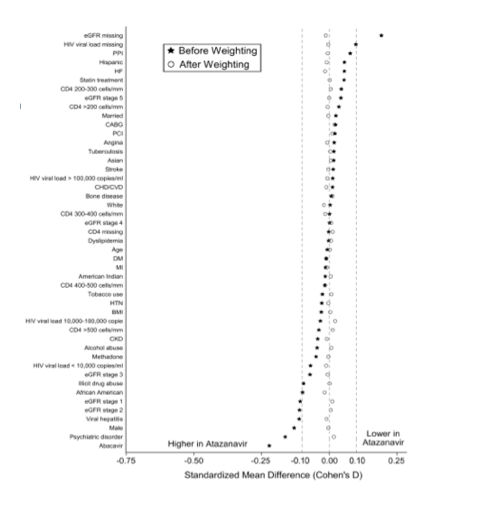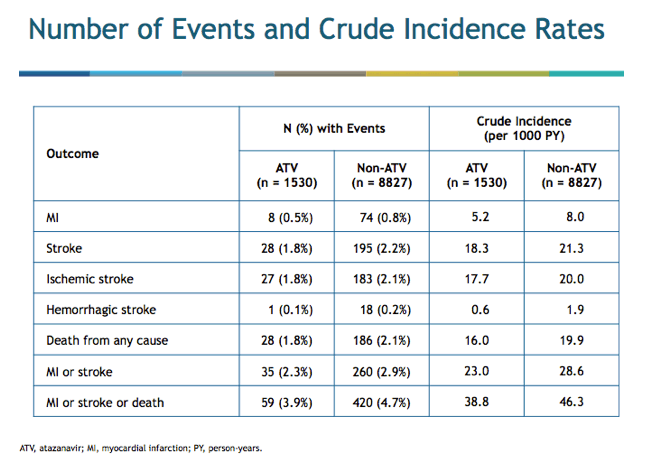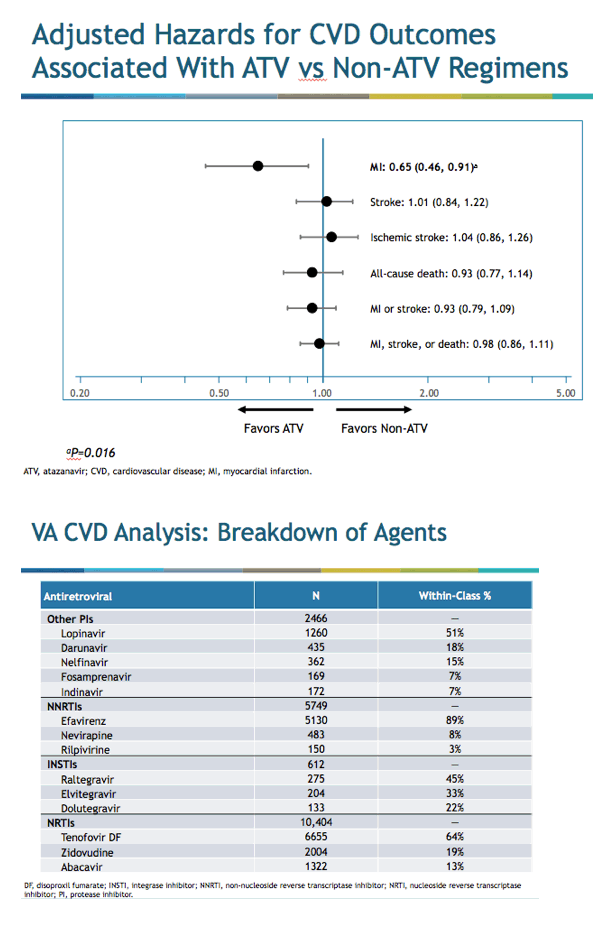 |
 |
 |
| |
One Third Lower MI Risk With Atazanavir Than Other ARVs in US Veterans
|
| |
| |
from Jules: panelists at Workshop suggested there is a U-shaped relationship in bilirubin affects.
"Bilirubin is a potent antioxidant that inhibits the oxidation of lipids and impacts multiple other aspects of the atherosclerotic process1,2"

18th International Workshop on Comorbidities and Adverse Drug Reactions in HIV, September 12-13, 2016, New York
Mark Mascolini
Compared with antiretroviral regimens not containing the protease inhibitor (PI) atazanavir, those that do carried a 35% lower risk of myocardial infarction (MI), according to results of a 1-year study of 10,000 US veterans [1]. Overall MI incidence was higher in this population than in other recent studies of HIV groups.
In AIDS Clinical Trials Group protocol 5260s, subclinical atherosclerosis gauged by carotid artery intima-media thickness progressed more slowly in people randomized to atazanavir/ritonavir than in those randomized to darunavir/ritonavir or raltegravir [2].
University of Utah investigators and colleagues at other centers proposed that atazanavir-associated hyperbilirubinemia may account for slower atherosclerosis progression with this PI because bilirubin in a potent antioxidant [1].
To determine whether this impact on atherosclerosis progression confers a lower risk of cardiovascular disease (CVD), the Utah group assessed rates of MI and stroke by ICD-9 and 10 codes in veterans who began antiretroviral therapy between January 2003 and December 2015 and received routine care from the Veterans Health Administration (VHA). Follow-up stopped if a veteran stopped taking an initial regimen for 30 days or left the VHA system. The researchers sought to reduce confounding and selection bias by estimating inverse probability of treatment weights.
The study group included 1532 veterans starting atazanavir and 8827 starting nonatazanavir regimens (2466 other PIs, 612 integrase inhibitors, and 5749 nonnucleosides). Age averaged 50 years in the atazanavir group and the nonatazanavir group, while respective proportions of blacks were 61% and 56%, whites 30% and 30%, and Hispanics 5% and 6%. One third in each group had a baseline viral load below 10,000 copies, and about 28% overall had a CD4 count below 200. While 10% of veterans in each group already had CVD, the same proportion used statins, and 27% used tobacco.
During an average follow-up of 12.8 months, 8 veterans taking atazanavir (0.5%) and 74 taking other regimens (0.8%) had an MI to yield crude incidence rates of 5.2 and 8.0 per 1000 person-years. The researchers counted 28 strokes (1.8%) in the atazanavir group and 195 (2.2%) in the comparison group for respective crude incidence rates of 18.3 and 21.3 per 1000 person-years. Respective rates of MI or stroke were 23.0 and 28.6 per 1000, and rates of MI, stroke, or death 38.8 and 46.3 per 1000.
Regression models controlling for demographics, HIV lab measures, comorbidities, and key comedications determined that veterans starting atazanavir rather than a nonatazanavir regimen had a 35% lower risk of incident MI (adjusted hazard ratio 0.65, 95% confidence interval 0.46 to 0.91, P = 0.016). This analysis found no between-group differences for stroke, ischemic stroke, all-cause death, MI or stroke, or MI, stroke, or death.
The researchers noted that nonatazanavir regimens consisted largely of contemporary combinations, with about three quarters of principal antiretrovirals listed as recommended or alternative first-line agents by the US Department of Health and Human Services treatment guidelines. They plan further CVD comparisons of atazanavir with individual antiretroviral classes. In the current analysis, half of the nonatazanavir PIs were lopinavir/ritonavir, noted for its impact on lipids.
The investigators observed that MI incidence in both study arms--5.2 and 8.0 per 1000 person-years--exceeds rates in previous HIV studies such as a 2010 D:A:D analysis (3.2 per 1000) [3]. Yet HIV cardiology expert Franck Boccara noted the unusually higher incidence of stroke than MI in this population and wondered whether MIs were actually underreported.
References
1. LaFleur J, Ritchings C, Bress A, Crook J, Sax PE, Rosenblatt L. Cardiovascular outcomes with atazanavir versus non-atazanavir containing antiretroviral regimens among HIV-infected veterans: a US national study. 18th International Workshop on Comorbidities and Adverse Drug Reactions in HIV, September 12-13, 2016, New York. Abstract O16.
2. Stein JH, Ribaudo HJ, Hodis HN, et al. A prospective, randomized clinical trial of antiretroviral therapies on carotid wall thickness. AIDS. 2015;29:1775-1783. https://www.ncbi.nlm.nih.gov/pmc/articles/PMC4571277/
3. Worm SW, Sabin C, Weber R, et al. Risk of myocardial infarction in patients with HIV infection exposed to specific individual antiretroviral drugs from the 3 major drug classes: the data collection on adverse events of anti-HIV drugs (D:A:D) study. J Infect Dis. 2010;201:318-330. http://jid.oxfordjournals.org/content/201/3/318.long









|
| |
|
 |
 |
|
|